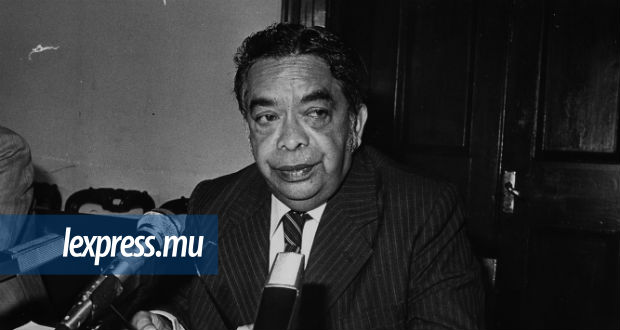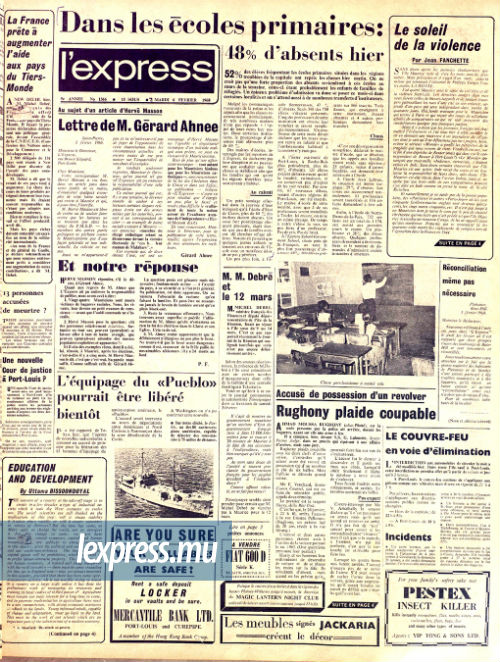Publicité
#50ansMoris: The eternal devaluation debate of the Mauritian rupee
Par
Partager cet article
#50ansMoris: The eternal devaluation debate of the Mauritian rupee

What should the value of the rupee be? This debate is as old as the country itself. In 1968, the pages of «l’express» hosted an article extolling the benefits of devaluation: exports would be cheaper and more competitive, more expensive imports would lead to more consumption of home-based industries (these, remember, were the import substitution days). But since that exhortation in the days of the nascent independent Mauritian state, devaluation of the currency has been a sobering experience in Mauritian political history and has often come at an exceptionally high political cost.
The first experience of dramatic rupee devaluation came in 1979. During the late 1970s, Mauritius faced a crippling economic situation: world sugar prices fell, hurting export earnings, and oil prices were climbing, hurting foreign exchange reserves. The then-Labour-PMSD government that had just managed to beat back the MMM in the 1976 elections was under pressure to deliver electoral sops to retain its support. Squeezed financially, the government faced a balance of payments deficit of US$ 111 million.

The then-Finance Minister, sir Veerasamy Ringadoo, lamented that the country was left with just enough to pay for two weeks’ worth of imports. The economic difficulties were such, historian Sydney Selvon writes in his A comprehensive history of Mauritius, that Ringadoo was forced to turn to the International Monetary Fund (IMF) for help in October 1979. Part of the price for the IMF’s aid was a 22.9 percent devaluation of the rupee, on 23 October 1979.
The step has massive political consequences for the government. The opposition MMM became even more critical of the government, the PMSD led by Gaëtan Duval and a coalition ally of government, threatened to split the coalition and a group of Labour party dissidents, led by Harish Boodhoo, who had been expelled from the party in July that same year, took a decidedly anti-government line. Jayen Cuttaree, in his Behind the purple curtain, an account of the history of the MMM, writes that the devaluation had plunged the country “in the midst of an economic crisis”.
Cuttarree wrote that, following the move, the MMM became “sure of winning the next elections” and decided to beef up its own economic doctrine as an alternative to the results delivered by the Labour-PMSD coalition. The devaluation had the effect of electrifying an already robust op- position against the Labour-PMSD coalition and brought all these disparate currents closer together. This was demonstrated in December 1979, a few months after the fall of the rupee, when the MMM and Harish Boodhoo’s newly-formed PSM jointly backed a no-confidence motion in Parliament.
This was a harbinger of the times to come. When the motion was presented to Parliament and was voted upon, according to Selvon, the government had barely just scraped through: 35 votes against the no-confidence motion and 33 in favour. It was not surprising to see why the 1979 devaluation had extracted such a heavy toll. In an official publication released in April 1981, the government had conceded that following the move, the cost of living had skyrocketed by 27 % in the space of one financial year. A government desperate to put its finances in order had tied its colours to the mast of economic shock therapy, and was paying the price for it.
But did the government’s gambit work? Unfortunately, for the Labour-PMSD dispensation, the devaluation and a series of related measures to boost competitiveness and investments did not really pan out. The continuing fall in export earnings from sugar (because the British pound sterling was also weakening) coupled with two cyclones that hit sugar production hard as well as continuing mistrust by the private sector regarding the political instability in the country combined to ensure that, before long, Mauritius had to go cap in hand once again to the IMF.
In fact, far from pulling Mauritius’ chestnuts out of the fire, 1980 was the only year in the history of independent Mauritius when the economy actually shrank. The price this time was another devaluation, by 16.7 percent on 27 September 1981. “Two massive devaluations in two years reflected badly on the fiscal policy performance of the government”, said the former Governor of the Central Bank, Ramesh Basant Roi, in a speech summarizing the history of Mauritian monetary policy, in November 2017.
The cumulative effects of the 1979 and 1981 rupee devaluations, the most drastic in the history of independent Mauritius, had played a large part in the turning point of 1982, when the Labour Party, that had run the country since independence in March 1968, was overthrown in an election with a 60-0 verdict; putting an end to one phase of the Labour Party and inaugurating another for the MMM and, eventually, giving rise to another party in due course, the MSM.
Today, in 2018, the debate over what the value of the rupee should be has scarcely changed since it was first brought up on these pages in 1968.
And the question still remains the same: are the supposed economic benefits of devaluation – now termed depreciation – worth the political/social costs that they entail? 50 years on, the jury is still out on that one and we are no closer to a definitive answer.
The economic context of the decision
<p>The decision to devalue came at a difficult economic squeeze in 1979. Mauritius, at the time, was overwhelmingly dependent upon sugar exports for the bulk of its foreign exchange earnings: in 1979, the Export Processing Zone brought in just Rs 603.2 million and the tourism sector only brought in 129,360 arrivals that year. The issue facing the government in 1979 was that it was caught in a pincer: on one hand, the government had granted successive wage increases, which in turn fueled imports since the 1974 sugar boom. Between 1978 and 1979 alone, imports rose by 18.1 percent. On the other hand, the world price of sugar had dropped to £ 92 per metric ton by July 1979, and, significantly, oil prices too went up. With more foreign currency flowing out to pay for imports than coming in, the trade deficit ballooned from just over one billion rupees in 1978 to Rs 1.2 billion by 1979. All in all, the current account nosedived from a surplus of Rs 127 million in 1975 (shortly after the sugar boom) to a Rs 735 million deficit by 1978. But it wasn’t just foreign exchange where the economy was taking a battering. Even the 1978-1979 government budget showed a deficit of Rs 283.6 million.</p>
<p>The government attempted to plug this widening gap on its books by approaching European states for loans, of which they could raise only approximately Rs 300 million. Not enough. And it was increasingly becoming clear that the state, from a combination of lower export earnings and increased imports and wages, was living way beyond its means. Faced with this conundrum, the government was finally forced to turn to the International Monetary Fund to help tide over its payments crisis and, in return, committed to devaluing the currency in 1979. When that proved to be not enough, they turned towards devaluation again as bitter medicine in 1981.</p>
After the riots: 48% of students in Port-Louis schools stay home
<p>On 6 February 1968, the capital was still in a state of insecurity. On this day, schools in the capital reopened once again only to find out that on the first day, 48 % of its students did not come to school due to security concerns. Within the capital too, the curfew regime put in place during the riots had been relaxed somewhat but with the capital still shuttered between 7 p.m. and 5 a.m.</p>
<p>Press reports from the day also gave details of arrests of those implicated in the violence : one inhabitant of Port-Louis sentenced to 3 months in prison by the Intermediate Court for possession of a firearm, two inhabitants of Cité Vallijee fined for breach of the peace and threatening a woman, amongst others. Amongst those arrested by the police while the violence was actually taking place, Ahmad Moussa Rughony pled guilty to illegal possession of a gun and six bullets. The French government has also announced that it was increasing its aid to third world countries. However, by 6 February 1968, it was still uncertain whether Michel Debré, then French Finance Minister and legislator elected from the French department of Reunion, as well as close friend of Gaëtan Duval, would be visiting Mauritius to attend its Independence Day celebrations on 12 March.</p>
Pierre Dinan, economist: «Currency depreciation (…) is just a non-transparent devaluation»
<div style="text-align:center">
<figure class="image" style="display:inline-block"><img alt="" height="330" src="/sites/lexpress/files/images/pierre_dinan2-ret.jpg" width="620" />
<figcaption></figcaption>
</figure>
</div>
<p><strong>What was the context preceding the economic hard times that led to the devaluations of 1979 and 1981? </strong></p>
<p>I have called the 1970s the wasted years. Mauritius had signed the commonwealth sugar agreement with the UK in the 1950s, since post-war Britain was suffering a sugar shortage and got its actual and former colonies to supply it with sugar in exchange for preferential prices. When the UK joined the European Common Market, Mauritius negotiated hard to keep that preferential pricing system and that resulted in the 1975 sugar protocol.</p>
<p>In 1974, there was a world sugar shortage. So, Mauritius negotiated and obtained higher prices from the UK and sold its excess output elsewhere at good prices too. 1974 was a boom year for Mauritius and the government was getting a lot in terms of taxes on sugar exports that went straight into the government coffers.</p>
<p><strong>So, where did it start going wrong? </strong></p>
<p>All this extra was used by the government at the time to mollify the opposition at home by rai- sing wages, laying the basis of the welfare state and the roots for the consumer society in Mauritius. This was a bad time from the governance point of view and promising these things was seen as one way of dealing with that. So, they promised a lot. But in 1975, sugar prices went down and the government found that it had made too many promises during the boom that it was finding difficult to sustain. But they could not go back on their promises either because of political constraints.</p>
<p>As the years went by, Ringadoo became more and more helpless and the government only got more and more popular as they tried to make up the shortfall by introducing all kinds of new taxes in each budget to meet the burden of public spending they had committed themselves to. By 1979, there was no money left in the kitty and they had no choice but to go to the IMF. And the devaluations followed from there.</p>
<p><strong>Did the IMF succeed during those years in correcting the government’s economic strategy? </strong></p>
<p>Back then, we had a very confused strategy. On the one hand, we wanted to promote exports, but this was not really taking off in the late 1970s. While on the other hand, we wanted to encourage import substitution with all sorts of things like processed peas, toothpaste, razors and things like that. We were really following two strategies at the same time.</p>
<p>What the IMF, rightly, said was that we had to commit to exports. But by then, the government was already very weak. The MMM was already a major party by the 1970s and the devaluations just ended up digging the grave of the government deeper.</p>
<p><strong>Were these experiences one reason why we moved to a floating rate in 1994 and stopped talking about devaluation but depreciation instead? </strong></p>
<p>You would have to ask a former central bank governor for the technical details. But I suspect that, by then, we had already reached the age of floating currencies, keeping a currency pegged and forcing a devaluation like that had become outmoded. So, there was no point in going through that anymore. Then, there is another side. What is the currency depreciation that we talk about today? It’s just a non-transparent devaluation. So, in that sense, it actually facilitates the job of the government and monetary authorities.</p>

Publicité
Publicité
Les plus récents






